Deaf ESL Students - Gallaudet University
Deaf ESL Students - Gallaudet University
Deaf ESL Students - Gallaudet University
Create successful ePaper yourself
Turn your PDF publications into a flip-book with our unique Google optimized e-Paper software.
By Francisca Rangel<br />
19, octubre, 1.999<br />
Istood with magic markers ready. It<br />
was mid-morning, time to present a<br />
lesson on bar graphs to my fourth<br />
graders at Kendall Demonstration<br />
Elementary School (KDES) on the<br />
<strong>Gallaudet</strong> <strong>University</strong> campus in<br />
Washington, D.C. I had already written<br />
the date on the board in Spanish as is<br />
my custom. I add the Spanish inscription<br />
to the English first thing every<br />
morning, partly to enrich the class and<br />
partly in recognition of the one child<br />
in my class from a Latino family.<br />
Juanita* is from El Salvador. Her<br />
mother died several years before and<br />
her father recently remarried. She<br />
seemed to be handling the situation<br />
with the quiet acceptance that she<br />
used to handle everything. Juanita was<br />
learning with children her own age.<br />
Her American Sign Language had<br />
blossomed and her knowledge of<br />
Spring 2000<br />
English was growing, too.<br />
Juanita’s eyes were among those<br />
watching me avidly when the smell<br />
wafted through our classroom. In the<br />
next class, the teacher and students<br />
had read Grace Maccarone’s Pizza<br />
Party and were cooking as a follow-up<br />
activity. The smell was rich, warm, and<br />
welcoming.<br />
Pizza.<br />
“Is that for us?” one of the students<br />
asked. All of them looked around<br />
eagerly. Thoughts of bar graphs vanished.<br />
“It’s not for us,” I explained. “It’s<br />
for other students.”<br />
Their reaction was instantaneous.<br />
“It’s not fair!” they cried.<br />
A few of my students inched toward<br />
the classroom divider. Two tried to<br />
peek underneath. Their classmates<br />
clamored over to join them. Even<br />
Juanita, usually among the most quiet<br />
in the class, couldn’t resist that smell.<br />
For an instant, I worried that decorum<br />
might break down entirely.<br />
And I had to empathize. My assistant,<br />
Melissa Knouse, an intern from<br />
<strong>Gallaudet</strong> <strong>University</strong>, and I looked at<br />
each other. If the pizza was making us<br />
ABOVE: The author, Francisca Rangel, with one of her students.<br />
hungry, what effect must it be having<br />
on our students?<br />
“Pizza is a great snack,” I agreed.<br />
The students shuffled about, displeasure<br />
evident on their faces. A few<br />
flashed me signs of discontent,<br />
although not Juanita. She has many<br />
American habits, but she is still<br />
extremely polite and respectful in the<br />
classroom—exactly as her parents<br />
would want her to be.<br />
“Let’s sit down.” I gestured to a<br />
small table and the students clustered<br />
around me. “What would be a good<br />
question to use for our bar graph?”<br />
“Snacks,” Chris responded.<br />
He thought for a moment and then<br />
formulated the question, “If we had a<br />
chance for a snack in class, what would<br />
it be?”<br />
Perfect. I wrote Chris’s question<br />
down on a sheet of paper.<br />
“Ashley, what’s your favorite snack?”<br />
I asked.<br />
“Pizza,” said Ashley. She was not<br />
pleased. But she was looking at me. So<br />
were her classmates.<br />
“French fries,” said Megan.<br />
Each child signed a response and I<br />
recorded it.<br />
19
















